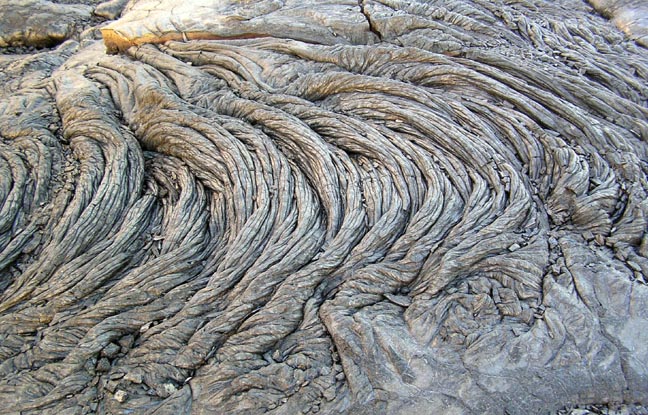
"Rope Like" Lava Rock
By Libby and Robert Strong and Richard Pollack
Science Rocks!!
Do you like rocks? Do you collect rocks? Rock collecting is a fun and easy hobby. Rocks are found just about everywhere. Real rocks are formed in nature, but sometimes you will find "man-made rocks" such as concrete. We will show you how to make a "kid-made rock" at home with the following activity.
Activity: Rock Cycle Candy
Caution !!!! Do this experiment under the supervision of an adult. This activity requires the use of a hot oven.
The following is a list of the materials you will need:
Several leftover candy canes or pieces of Christmas hard candy
Cupcake or muffin pan
Several cupcake liners for baking individual cupcakes (metal foil variety)
1 large metal spoon
Hot pad for the cupcake or muffin pan
Kitchen timer
1 teaspoon measuring spoon (5 ml)
2 pot holders 2 oven mitts work best
Several zip lock plastic bags
Oven pre-heated to 350 degrees F (177 degrees C)
Procedure:
Step 1: Place several pieces of hard candy or 1 large candy cane into a zip lock plastic bag. (Note: This is enough candy for 1 kid-made piece of rock cycle candy. If you want to make more for later, increase the amounts.)
Step 2: Squeeze out as much air as possible before sealing the plastic bag.
Step 3: Place the candy in the zip lock bag on to a hard counter top (do not do this on a glass table top, soft wooden cutting board, or valued family antiques or heirlooms).
Step 4: Using the rounded part of the metal spoon (not as a hammer), tap the hard candy or candy cane until it crumbles into small pieces about 1/8 inch (3 or 4 mm) in size. Do not turn the hard candy or candy cane into a fine powder.
Step 5: Place one cupcake liner for each piece of rock cycle candy you plan to make into the cupcake or muffin pan.
Step 6: Using the measuring spoon, place 2 level teaspoons (10 ml) of crushed hard candy or candy cane into the bottom of each of the foil liners.
Step 7: Place the cupcake or muffin pan into the preheated oven set to 350 degrees F (177 degrees C).
Step 8: Set the kitchen timer for 7 minutes. Do not go away. Do not watch TV. Do not go outside to play with your friends.
Caution: Do not leave the experiment in the oven longer than 7 or 8 minutes. The candy can burn.
Step 9: When 7 minutes has passed, use the oven mitts to remove the cupcake pan from the oven. Place the cupcake pan on the top of the hot pad and wait for the very hot candy to cool. DO NOT TOUCH YET!!!!
Observe the candy in the foil liners. Has the candy changed? What does it look like? When the candy is completely cooled (adults will tell you when this is), remove it from the foil and observe it. Give it a taste.
Real Hot Rocks
Real lava is not made of sugar, or candy (too bad!), but rock can also melt if it gets hot enough. Did you know that the interior of the Earth is HOT? We mean real hot so very, very hot that the rock actually melts. When rock melts completely to form magma (liquid hot rock beneath the Earth's surface) or lava (liquid hot rock on the Earth's surface) it can flow like a thick, syrupy liquid. When the magma or lava cools, it will form solid rock. This type of rock is called igneous rock. The word igneous means "from fire". Can you think of any other words that are similar to the word igneous? Use a dictionary to help you.
Recently Libby and Robert visited Volcanoes National Park on the Big Island of Hawai¹i and closely investigated the lava flows that have been erupting since the 1980s. The image below shows "rope like" lava rock.

"Rope Like" Lava Rock
To see a gallery of Hawai¹i photos featuring hot lava and other geologic features, please visit our website at http://www.smartcenter.org/ovpm/hawaiiimages
Rock is constantly "recycling". All kinds of rock can weather or break into pieces and be eroded by water, ice, or wind. These resulting small pieces of rock can cement together over time and form a sedimentary rock. Heat and pressure can change rocks. Rocks after they are changed by heat and pressure are called metamorphic rocks. To learn more about the awesome process of rock "recycling" see our website at http://www.smartcenter.org/ovpm/rockcycle
What's Up? Spectacular Saturn
On January 27, 2006 the solar system's second largest planet, the ringed
planet Saturn, will be the closest it will come to the Earth until 2029.
On this evening the planet Saturn will be brighter than usual giving us
an unparalleled view of the gas giant and the famous ring systems.
Saturn will be rising in the east around sunset. Look for a non-twinkling
yellowish star like object on the opposite side of the sky from the Sun.
If you want to see the ringed planet through a telescope, join the staff
of the WLSC SMART-Center, Near Earth Object Foundation, and members of
the ASTROLABE Astronomy Club at the Brooke Hills Park Club House on January
27 at 7:00 p.m.. The event is free to the public. For more
information on upcoming free astronomy events at Brooke Hills Park, visit
our website: http://www.smartcenter.org/whatsup